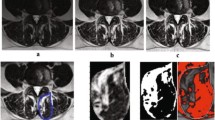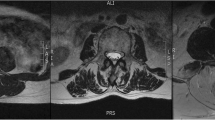Abstract
The purpose of this study was to investigate the use of magnetic resonance (MR) imaging and image processing software to determine the functional cross-sectional area (FCSA) (the area of muscle isolated from fat) of the lumbar paraspinal muscles. The measurement of the morphology of the lumbar paraspinal muscles has become the focus of several recent investigations into the aetiology of low back pain. However, the reliability and validity of determining the FCSA of the lumbar paraspinal muscles using MR imaging are yet to be reported. T2 axial MR scans at the L1-S1 spinal levels of six subjects were obtained using identical MR systems and scanning parameters. Lean paraspinal muscle, vertebral body bone and intermuscular fat were manually segmented using image analysis software to assign a grey scale range to the MR signal intensity emitted by each tissue type. The resultant grey scale range for muscle was used to determine FCSA measurements for each of the paraspinal muscles, psoas, quadratus lumborum, erector spinae and lumbar multifidus on each scan slice. As various biological, instrument and measurement factors can affect MR signal intensity, a sensitivity analysis was conducted to determine the error associated in calculating FCSA for paraspinal muscle using a discrete grey scale range. Cross-sectional area and FCSA measurements were repeated three times and reliability indices for the FCSA measurements were obtained, showing excellent reliability, intra class correlation coefficient (mean=0.97, range 0.90–0.99) and %SEM (mean=2.6%, range 0.7–4.8%). In addition, the error associated with miscalculation of the grey scale range for the MR signal intensity of muscle was calculated and found to be low with an error of 20 grey scale units at the upper end of the muscle’s grey scale range resulting in a very small error in the measured muscle FCSA. The method presented in this paper has a variety of practical applications in areas such as evidence-based rehabilitation, biomechanical modelling and the determination of segmental inertial parameters.





Similar content being viewed by others
References
Barra V, Boire J-Y (2002) Segmentation of fat and muscle from MR images of the thigh by a possible clustering algorithm. Comput Methods Programs Biomed 68:185–193
Boos N, Boesch C (1995) Quantitative magnetic resonance imaging of the lumbar spine. Potential for investigations of water content and biochemical composition. Spine 20:2358–2365
Cheng CK, Chen HH, Chen CS, Lee CL, Chen CY (2000) Segment inertial properties of Chinese adults determined from magnetic resonance imaging. Clin Biomech 15:559–566
Dangaria T, Naesh O (1998) Changes in cross-sectional area of psoas major muscle in unilateral sciatica caused by disc herniation. Spine 23:928–931
Danneels L, Vanderstraeten G, Cambier D (2000) Computed tomography imaging of trunk muscles in chronic low back pain patients and healthy control subjects. Eur Spine J 9:266–272
Danneels L, Vanderstraeten G, Cambier D, Witvrouw E, Bourgois J, Dankaerts W, De Cuyper H (2001) Effects of three different training modalities on the cross sectional area of the lumbar multifidus muscle in patients with chronic low back pain. Br J Sports Med 35:186–191
Davey P, Eardley C, Elliot S, Torkelson A, Rabey M (2000) A quantitative analysis of lumbar multifidus in subjects with chronic lumbar segmental instability. Unpublished Masters of Science Thesis. Curtin University of Technology. Perth, Australia
Engstrom C, Walker D, Kippers V, Buckley R (2000) Quadratus lumborum asymmetry and pars interarticularis injury in cricket fast bowlers: a prospective MRI examination. 2000 Pre Olympic Conference on Sports science, sports medicine and physical education. Sydney, NSW Sports Medicine, Australia, pp 191–192
Gatton M, Pearcy M, Pettet G (1999) Difficulties in estimating muscle forces from muscle cross-sectional area. An example using the psoas major muscle. Spine 24:1487–1493
Harris G, Andreasen NC, Cizaldo T, Bailey JM, Bockholt J, Magnotta VA, Arndt S (1999) Improving tissue classification in MRI: a three-dimensional multispectral analysis method with automated training class selection. J Comput Assist Tomogr 23:144–154
Hides JA, Richardson C, Jull GA (1995) Magnetic resonance imaging and ultrasonography of the lumbar multifidus muscle: comparison of two different modalities. Spine 20:54–58
Hides JA, Richardson C, Jull GA (1996) Multifidus muscle recovery is not automatic after resolution of acute, first episode, low back pain. Spine 21:2763–2769
Hides JA, Stokes MJ, Saide M, Jull GA, Cooper DH (1994) Evidence of lumbar muscle wasting ipsilateral to symptoms in patients with acute/subacute low back pain. Spine 19:165–172
Hoad CL, Martel AL (2002) Segmentation of MR images for computer-assisted surgery of the lumbar spine. Phys Med Biol 47:3505–3517
Hodges P, Richardson C (1997) Contraction of the abdominal muscles associated with movement of the lower limb. Phys Ther 77:132–144
Kader DF, Wardlaw D, Smith FW (2000) Correlation between the MRI changes in the lumbar multifidus muscles and leg pain. Clin Radiol 55:145–149
Kamibayashi LKR, Richmond FJR (1998) Morphometry of the human neck muscles. Spine 23:1314–1323
Kaser L, Mannion A, Rhyner A, Weber E, Dvorak J, Muntener M (2001) Active therapy for chronic low back pain. Spine 26:909–919
Keller A, Brox JI, Gunderson R, Holm I, Friis A, Reikerås O (2004) Trunk muscle strength, cross-sectional area, and density in patients with chronic low back pain randomized to lumbar fusion or cognitive intervention and exercises. Spine 29:3–8
Lieber RL, Friden J (2000) Functional and clinical significance of skeletal muscle architecture. Muscle Nerve 23:1647–1666
Mannion AF, Kaser L, Weber E, Rhyner A, Dvorak J, Muntener M (2000) Influence of age and duration of symptoms on fibre type distribution and size of the back muscles in chronic low back pain patients. Eur Spine J 9:273–281
Marras WS, Jorgensen MJ, Granata KP, Wiand B (2001) Female and male trunk geometry: size and prediction of the spine loading trunk muscles derived from MRI. Clin Biomech 16:38–46
Martin PE, Mungiole M, Marzke MW, Longhill JM (1989) The use of magnetic resonance imaging for measuring segment inertial properties. J Biomech 22:367–376
McGill S, Santaguida L, Stevens J (1993) Measurement of the trunk musculature from T5 to L5 using MRI scans of 15 young males corrected for muscle fibre orientation. Clin Biomech 8:171–178
McGill SM, Norman RW (1986) Effects of an anatomically detailed erector spinae model on L4/L5 disc compression and shear. J Biomech 20:591–600
Meier DS, Guttmann CRG (2003) Time-series analysis of MRI intensity patterns in multiple sclerosis. Neuroimage 20:1193–1209
Mitsiopolous N, Baumgartner RN, Heymsfield SB, Lyons W, Gallagher D, Ross R (1999) Cadaver validation of skeletal muscle measurement by magnetic resonance imaging and computerized tomography. J Appl Physiol 85:115–122
Norton K, Marfell-Jones M, Whittingham N, Kerr D, Carter L, Saddington K, Gore C (2000) Anthropometric assessment protocols. In: Gore C (ed) Physiological tests for elite athletes. Human Kinetics, Lower Mitcham, pp 66–85
O’Sullivan P (2000) Lumbar segmental ‘instability’: clinical presentation and specific stabilizing exercise management. Man Ther 5:2–12
Panjabi M (1992) The stabilizing system of the spine. Part 1 and Part 2. J Spinal Disord 5:390–397
Parkkola R, Rytokoski U, Kormano M (1993) Magnetic resonance imaging of the discs and trunk muscles in patients with chronic low back pain and healthy control subjects. Spine 18:830–836
Pearsall DJ, Reid JG, Ross R (1994) Inertial properties of the human trunk of males determined from magnetic resonance imaging. Ann Biomed Eng 22:692–706
Reid JG, Jensen RK (1990) Human body segment inertia parameters: a survey and status report. Exerc Sport Sci Rev 18:225–241
Rinck PE (1993) Magnetic resonance in medicine. Blackwell, Oxford
Sebastian TB, Huseyin T, Crisco JJ, Kimia BB (2003) Segmentation of carpal bones from CT images using skeletally coupled deformable models. Med Image Anal 7:21–45
Storheim K, Holm I, Gunderson R, Brox JI, Bo K (2003) The effect of comprehensive group training on cross sectional area, density and strength of paraspinal muscles in patients sick listed for subacute low back pain. J Spinal Disord Tech 16:271–279
Vasavada AN, Li S, Delp S (1998) Influence of muscle morphometry and moment arm on the moment generating capacity of human neck muscle. Spine 23:412–422
Westbrook C, Kaut C (1998) MRI in practice. Blackwell, Oxford
Wilke H, Wolf S, Claes L, Arand M, Weisend A (1995) A stability increase of the lumbar spine with different muscle groups: a biomechanical in vitro study. Spine 20:192–198
Author information
Authors and Affiliations
Corresponding author
Additional information
Research carried out at Edith Cowan University, Western Australia and the University of Nottingham, UK. The experiments comply with the current laws of the country in which they were performed in and ethical approval for the study was granted by the Local and Regional ethics committees of Edith Cowan University, Western Australia and the University of Nottingham, UK.
Rights and permissions
About this article
Cite this article
Ranson, C.A., Burnett, A.F., Kerslake, R. et al. An investigation into the use of MR imaging to determine the functional cross sectional area of lumbar paraspinal muscles. Eur Spine J 15, 764–773 (2006). https://doi.org/10.1007/s00586-005-0909-3
Received:
Revised:
Accepted:
Published:
Issue Date:
DOI: https://doi.org/10.1007/s00586-005-0909-3




